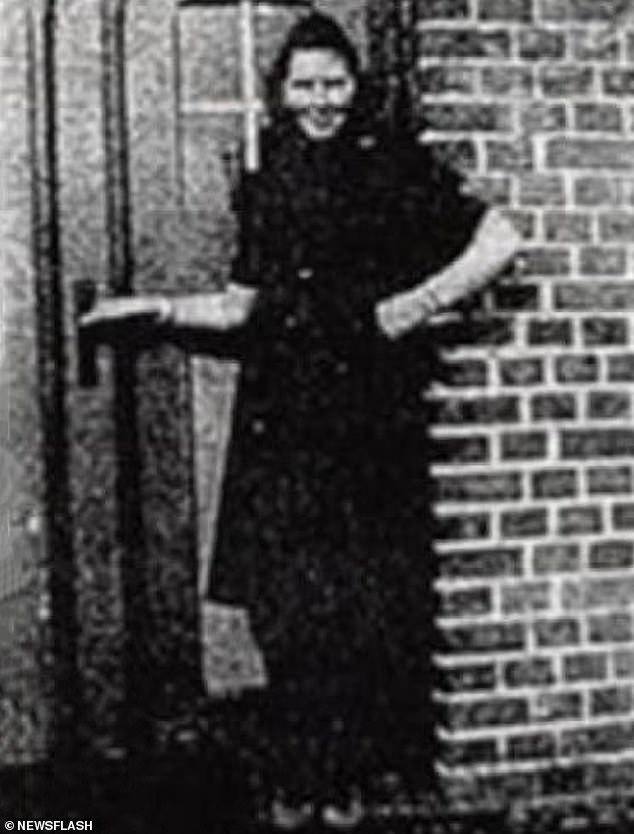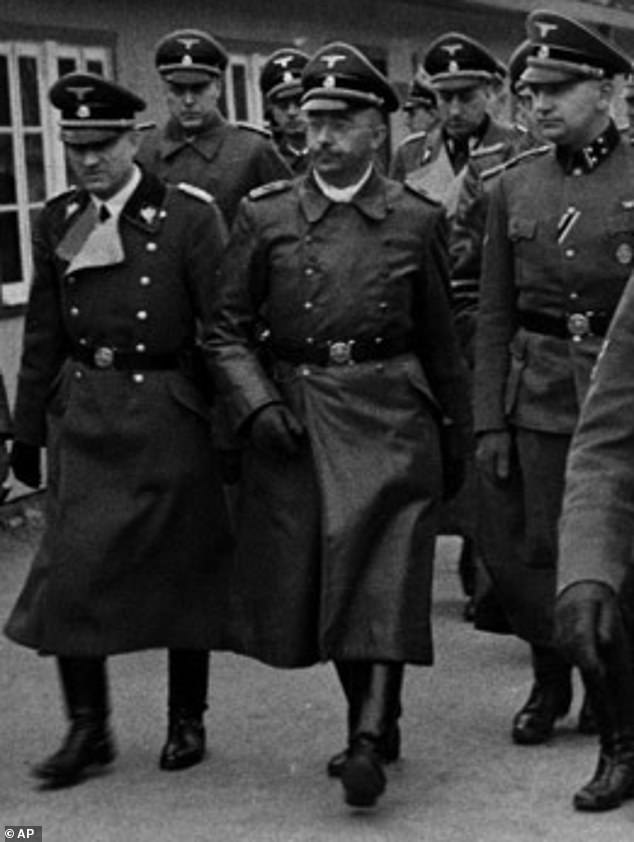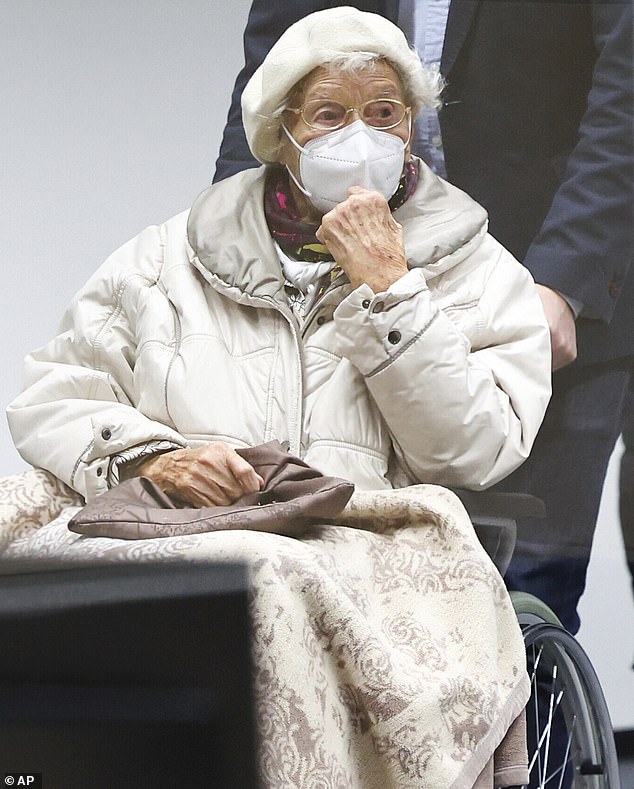As she was pushed into court in a wheelchair, the elderly woman’s face was hidden behind a patterned silk scarf.
Sunglasses and a medical mask further protected her from press photographers, who had been allowed to take pictures for a short period. Irmgard Furchner was the first woman in decades to be tried on charges related to the atrocities of the Third Reich.
The trial began three years ago – bizarrely – in a juvenile court near Hamburg, Germany. She was just 18 when she started working as a secretary for the Stutthof camp commandant. I saw that she was wearing an electronic bracelet on her arm. It had been fitted after she fled her nursing home to avoid trial, an act that seemed to show she understood the gravity of her situation.
Bear in mind that this woman was charged with complicity in the deaths of 11,400 people at Stutthof on Poland’s Baltic coast, which became the first Nazi camp outside Germany when it opened two days after the outbreak of war.
Despite her claims of innocence, Furchner was found guilty of complicity in mass murder and given a two-year suspended sentence. Last week, Germany’s Federal Court rejected her appeal against the conviction, as she is now 99 years old.
Irmgard Furchner was the first woman to stand trial on charges related to Third Reich atrocities in decades.
When I first saw her in 2021, she looked sad and pathetic, just like the 100-year-old man I saw two days later in another German court, dressed in a striped sweater and complaining of difficulty sleeping as he faced similar charges. The Lithuanian-born centenarian could not have looked less menacing. Yet this man, Josef Schutz, was found guilty of aiding and abetting the killing of 3,518 people at the Sachsenhausen concentration camp near Berlin.
Not that he ever saw the inside of a cell. He was allowed to remain free while he appealed his five-year sentence, but died last year.
It was strange to see on the courtroom television screens the eerily familiar black-and-white images of Nazi guards strutting through those grotesque fields, and then to look first at Furchner and then at Schutz, listening to claims that they were crucial cogs in the Nazi machinery of mass murder.
The horror of the past intertwined with present reality as Germany hunted down some of the last surviving alleged perpetrators of these crimes against humanity.
This wave of cases followed the 2011 conviction of John Demjanjuk, a former guard at the Sobibor concentration camp. Previously, German cases required proof of involvement in a murder. However, after that case, anyone who worked at such a place could be tried as an accessory to the murders committed there.

This woman was accused of complicity in the deaths of 11,400 people in Stutthof, on the Baltic coast of Poland (Furchner photographed in 1944)
I was surprised by my reaction to seeing these frightened old men. Before such trials, I had mixed feelings, torn between the enormity of the Nazi crimes and the age of the accused, as well as the comparatively minor role they played.
But my attitude hardened as I looked at that miserable old woman and that even older man. I became convinced that these trials were right, even though they had been held decades too late and the defendants were in the dock partly because they had lived longer than their contemporaries.
Oddly, it was the simple normality of the defendants that strengthened my desire for justice. The banality of evil was made clear when Schutz listened through his headphones (due to his hearing difficulties) and Furchner fiddled with his sunglasses.
At one point, Heike Trautmann, a high-ranking police officer, showed court records of Schutz’s service in the SS after he responded to the Führer’s call to join the Nazi cause.
Trautmann revealed that during the 40 months Schutz was a guard at Sachsenhausen there were 38,110 deaths: “They were gassed, shot or died as a result of malnutrition and poor hygiene.”

Heinrich Himmler (center) at Stutthof, the first Nazi camp outside Germany
He asked a court official for help in unrolling the list on which Sachsenhausen staff had detailed the daily murders of Allied prisoners, political opponents and “antisocials” such as Jews and Gypsies. Incredibly, it was 14 metres long.
This was a startling indication of the scale of these crimes and a reminder that even the most disturbing evil is carried out not by monsters or freaks, but by ordinary people, driven by typical human traits such as ambition, fear or a misguided sense of duty.
The Nazi regime needed bureaucrats, guards and secretaries to function effectively, and as historian Rachel Century told me, if enough people had refused to cooperate, millions of lives could have been saved.
Of the 110,000 inmates held at Stutthof, some 64,000 died, including some 28,000 Jews, political prisoners, homosexuals and survivors of the Warsaw Uprising. Many were executed, but others died of disease, exhaustion and starvation.
Asia Shindelman was 15 years old (three years younger than Furchner) when she was taken to Stutthof in a cattle truck with her family. She told me of watching her grandmother being taken away to be murdered, prisoners being thrown into electrified fences, and men being fed to dogs “like meat.”
“It’s not possible for anyone to say that they didn’t know what was happening around them,” said Shindelman, who was among the four percent of Lithuanian Jews who survived the Holocaust. “We didn’t look like people, we looked like skeletons.”
We can easily blame leaders for wrongdoing, but the potential for depravity lurks beneath the surface of all human societies. Throughout my life, I have seen it repeatedly: from the slaughter of two million Cambodians under the despotic Pol Pot and the genocide in Rwanda to the most recent events in the Middle East.
Or if you look at the horrendous massacre of murder, rape and torture being carried out by Russian soldiers and their henchmen in Ukraine, is it any wonder that Ukrainians are enraged when foreigners nonchalantly blame Putin alone for the nightmare that is befalling their nation?
I have met many victims of abuse and torture whilst working as a journalist around the world and have often wondered how anyone could commit such atrocities.
A few weeks before attending those trials, I interviewed a Chinese policeman who told me how he had helped beat and brutalize Uighurs during the dictatorial crackdown on Muslim minorities. He spoke of whipping people until they were blind and using electric batons on their genitals.
This man was a whistleblower who fled China in disgust at his own role in those sordid events. He was remorseful, but he demonstrated how a perverse sense of duty and fear of punishment led an ordinary man to help torture innocent people.
That’s why those judgments matter and why I changed my mind when I looked at those two old men.
They remind us how ordinary men and women assist and carry out the most terrible crimes.
And for the sake of humanity, we must send a strong message to all those who participate in such atrocities: that they will never be safe from justice.

